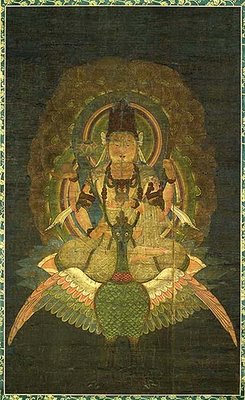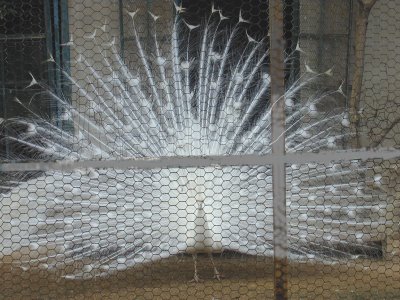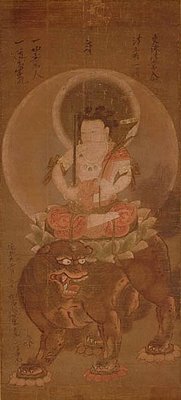[ . BACK to Worldkigo TOP . ]
. Ta no Kami 田の神 God of the Fields .
. Yama no Kami 山の神 God of the Moutain .
:::::::::::::::::::::::::::::::::::::::::::::::::::::::::::::::::::::::::::::::::::::::::::::::::::::
Ta no Kami, God of the Rice Fields 田の神さま
paddy field kami, god of the rice paddies, spirit of the rice field
sanbai さんばい, see below.

In rural areas the polar structure of the cult of
the field- or mountain deity (ta no kami / yama no kami) plays an important role. Before the spring sowing the figure of the deity is carried from the woods above the village to the house, where it is set up in the cult niche (tokonoma) to preside over a festive banquet.
Finally it is carried to a particular place in the fields, from where it will protect the growing rice. In autumn the festival procedure is reversed.
The Shinto cult system is evidently rooted in Japanese prehistory. Its origins must be seen essentially in pre-Buddhistic agricultural rites (e.g. ta no kami/ yama no kami) and territorial village- or clan-cults (uji, ujigami).
http://home.worldcom.ch/negenter/410JapHouseTxE2.html
.......................................................................
Yama no Kami 山の神 has only one eye
Amanomahitotsu no kami 天目一箇神(あめのまひとつのかみ)
Amatsumara 天津麻羅
 source : google.co.jp
- quote -
Amatsumara 天津麻羅
source : google.co.jp
- quote -
Amatsumara 天津麻羅
Other names:
Amenomahitotsu no kami (Kogo shūi)
A kami of ironworking (kajishin).
Kojiki states that as the blacksmith of the Plain of High Heaven, Amatsumara was called upon to refine the iron used for making mirrors, using the "hard rocks of heaven" and the "metal mountain of heaven" located above the "Tranquil River of Heaven" (Amenoyasukawa). Together with Ishikoridome, he was said to have assisted in the making of the mirror used to lure Amaterasu from her hiding place in the rock cave of heaven. The name Amatsumara means ma-ura ("eye divination"), which some believe means "
one-eyed," a reference to an occupational hazard of blacksmiths.
Kogo shūi describes Amatsumara as a follower of Futodama; it also states that at the time of Amaterasu's hiding away in the rock cave of heaven,
Amenomahitotsu no kami ("the one-eyed kami of heaven") was assigned to make metal weapons, and that during the reign of Emperor Sujin, the descendants of that kami were, together with the descendants of Ishikoridome, put in charge of recasting the divine mirror and sword.
According to an "alternate writing" included in Nihongi, Amenomahitotsu was designated by Takamimusuhi as a metalworker to serve the kami of Izumo. From these incidents, Amenomahitotsu is recognized as the same kami as Amatsumara.
According to Sendai kuji hongi, among the gods who subjected themselves to Ninigi at the time of his descent from heaven (tenson kōrin) were kami named Amatsumara or Amatsumaura. Nihongi's record of the reign of Emperor Suizei likewise mentions the name Yamato no Kanuchi Amatsumaura is mentioned. The name Amatsuma(u)ra refers to the ancestral tutelary (sojin) of the blacksmith occupational groups, and was apparently also used as a common name.
- source : Mori Mizue, 2005, Kokugakuin
This deity with one eye and one leg comes to the fields to protect them before the harvest, now in the form of a kakashi, with one leg and one eye.
Even the modern yellow plastic balloons with one black ring, which hang in the fields, are a modern version of this deity with one eye.
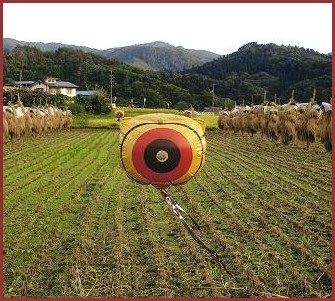
:::::::::::::::::::::::::::::::::::::::::::::::::::::::::::::::::::::::::::::::::::::::::::::::::::::
Noto Peninsula 能登半島 Noto Hantoo
ae no koto, aenokoto あえのこと / アエノコト / 饗事
Entertaining the God of the Fields
Nowadays there are few families who continue this ritual, which is passed on from father to son. It is an intangible cultural property of Japan and the UNESCO.

On November 5 of the old lunar calendar, now December 5, the God of the Fields is invited into the home by the elder of the family, clad in formal hakama trousers and a robe with the family crest. He gets a great offering from the harvest. The elder sits in front of the tokonoma, where a scroll with the blind deity is hung. He tells him all the things. One important item is a two-pronged large radish, to symbolize fertility. All food offerings are given in two portions, for the God of the Fields and his Wife. There are two sets of chopsticks for the deities.

The God of the Fields partakes of the meal and is then ushered to the bathroom, to take a bath. Again, the elder tells him all the things in the place and then lets him enjoy the bath. He is then taken back to the living room and resides in the tokonoma. The whole family partakes of the offered meal now.
The God of the Fields resides with the family until the next year, on the 9th day of the first lunar month, now February 9.
On this day, the god receives the New Year greetings, gets another bath and is then shown out of the house to the field. The elder takes a sacred pine twig and a flask of sake to the fields.
On the next day, Feburary 10, the elder performs the ritual of the first hoe
. kuwa hajime, kuwahajime 鍬始
kuwa matsuri 鍬祭り festival of the hoe
and on the next day, February 11, the
tauchi shoogatsu 田打正月(たうちしょうがつ)
ritual New Year ploughing
:::::::::::::::::::::::::::::::::::::::::::::::::::::::::::::::::::::::::::::::::::::::::::::::::::::
The Field Gods of Kagoshima, Kyushu
鹿児島の田の神さあ ta no kansaa
tanokamisaa ta no kamisaa
Ta no Kami and their counterpart,
Yama no Kami, the God of the mountains are popular all over Japan. Usually in Winter the Field God retreats to the mountains and comes back in Spring.
In Kyushu, the
Ta no kansaa 田の神さあ is still venerated in more than 300 communities. In some areas, he is not only responsible for the fertility of the fields but also the humans. It is custom to carry a stone statue of the God to a couple that has just married and leave the stone statue there for one year. He sits in the Tokonoma, the alcove, and is venerated every day.
After one year, when hopefully the first sone of the couple has been born, he is carried off in a humorous festival to the next couple that has just married. He has his face and features colored anew and then is placed in a bamboo carrier decorated with seasonal flowers in the yard of the house. The unmarried men under 25 of the village, dressed in female cloths, with huge hats and painted their face black, dance around the statue. Then they smear the faces of all visitors black too and finally carry off the statue.
The black face will protect the people from eveil during the following year.
The statue is first carried back to the field, where the dancing goes on and the deity can recover its fertile powers. The god is than carried through the village again and finally in the evening brought to the home of a newly-wed couple, where he will reside and work his wonders for another year.
We saw a young couple with a baby and the young father told about his parents, who also had the same stone statue in the house when he was born. Thus the village tradition is well alive these days.
Gabi Greve
(seen at NHK, April 10, 2006)
. Lava Figures from Kagoshima .
Dancing in the fields
鹿児島県 祁答院町麓西
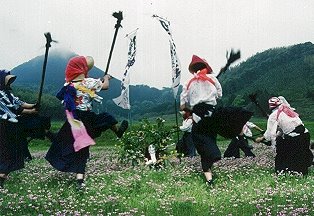 The newly wed with black faces
The newly wed with black faces
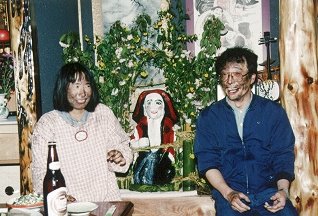 http://www.maff.go.jp/soshiki/koukai/muratai/21j/no1/mura21.html
http://www.maff.go.jp/soshiki/koukai/muratai/21j/no1/mura21.html
:::::::::::::::::::::::::::::::::::::::::::::::::::::::::::::::::::::::::::::::::::::::::::::::::::::
Read inJapanese about "Ta no Kansaa"
with many more photos.
Ta no Kansaa in Kagoshima
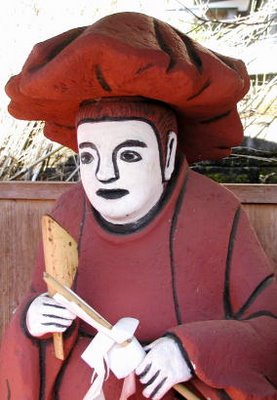 Ta no Kami of the Nishida Fields
Ta no Kami of the Nishida Fields
西田の田の神さあ
姶良郡姶良町下名西田
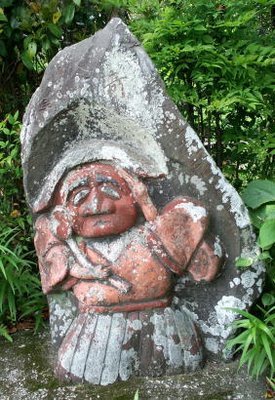 http://www.d1.dion.ne.jp/~itaru_/tanokami4.htm
Yoshikatsu also has a great site about Stone Buddhas
http://www.d1.dion.ne.jp/~itaru_/tanokami4.htm
Yoshikatsu also has a great site about Stone Buddhas
よしかつ の石仏HP
http://www1.kcn.ne.jp/~yosikatu/
:::::::::::::::::::::::::::::::::::::::::::::::::::::::::::::::::::::::::::::::::::::::::::::::::::::
The belief in the Ta no Kami might be related to the WOLF lore in Japan.
... there seems also to have existed a belief that if one encountered an okami (wolf) on a mountain and "treated him kindly", he would bestow kindness in return, and protect the man against other dangers. This may have to do with the belief, current in many parts of Japan, that the okami is a messenger of the gods, especially also of Yama-no-kami, the Mountain-deity, who during agricultural activities of the humans descends from her mountain residence to act as
Ta-no-kami, the Field-deity.
(While commonly conceived as a female, Yama-no-kami may at times be a male; as usual with kami, the sex is variable.) Possibly as Yama-no-kami/Ta-no-kami's messenger, the wolf was thought of as a kind of protector of the rice against evil goblins.
[In Central Java a "wer tiger" guards the plantations at night against the destructive wild pigs; in the Yucatan the balams (magicians) took on an animal shape to guard the corn-fields!] No doubt originally similar ideas applied to both as Ta-no-kami's wolf and Inari-san's fox, depending on locality.
From:
Fox and badger and other witch animals of Japan
by U.A. Casal
Read more here
http://www.swampfox.demon.co.uk/utlah/Articles/japwolf.html
noogami 農神 / ノウガミ様 -
obosuna sama オボスナ様 / おぼすな様 Ubusuna deity
deity for agriculture, especially the rice fields
. Sake 酒 rice wine for regional rituals .
:::::::::::::::::::::::::::::::::::::::::::::::::::::::::::::::::::::::::::::::::::::::::::::::::::::
 Yama no Kami 山の神, God of the Mountain,
Yama no Kami 山の神, God of the Mountain,
God of the Forest
The farmhouse is a temple between the fields and the woods.
The fields stand for the work of cultivation, the woods are untamed nature.
The polar pattern of the cult of the field-and-forest god (ta no kami - yama no kami, where yama is the wooded slope above the village, so that the interpretation of
"mountain god" would be wrong) provides the basic pattern and the framework for the whole calendar of
festivals of the rice year (inasaku-girei).
Read the full story here:
JAPANESE RICE CULTURE, by Nold Egenter
:::::::::::::::::::::::::::::::::::::::::::::::::::::::::::::::::::::::::::::::::::::::::::::::::::::
................ Haiku 俳句
Related Kigo for Late Spring
preparing a seat for the Field God,
..... ta no kami no koshikake 田の神の腰掛
Ceremony of Opening the Water Channels
..... mizuguchi matsuri 水口祭
Ceremony for the Seeds
..... tane matsuri 種祭
..... nawashiro matsuri 苗代祭
A Haiku Collection called
Ta no Kami
from Mizuta Mitsuo
水田光雄 『田の神』句集
ooo ooo ooo ooo ooo ooo ooo ooo ooo
田の神へ一番刈りの稲供ふ
ta no kami e ichiban kari no ine sonau
to the god of the field
we offer this first
bundel of rice
山本悦子 Yamamoto Etsuko
http://www.ibukinet.jp/topix/topix07.html
(Tr. Gabi Greve)
xxxxxxxxxxxxxxxxxxxxxxxxxxxxx
田の神の眠りを醒ますとんどかな
ta no kami no nemuri o samasu tondo kana
awakening the
god of the fields -
fire offerings
河本秀也 Kawamoto Hideya
http://www.nhk.or.jp/haiku/html/haiku18-2-25.htm
(Tr. Gabi Greve)
TONDO: Read my explanation about Sankuroo and Daruma
三九郎とだるま
dondoyaki, tondoyaki
:::::::::::::::::::::::::::::::::::::::::::::::::::::::::::::::::::::::::::::::::::::::::::::::::::::
Related Kigo for early summer
 sanbai oroshi さんばい降し (さんばいおろし)
sanbai oroshi さんばい降し (さんばいおろし)
calling the god of the fields
sanbai matsuri さんばい祭(さんばいまつり)festival for the god of the fields
sanbai okuri さんばい送り(さんばいおくり)
sanbai machi さんばい待ち(さんばいまち) waiting for the god of the fields
sanbai is another name for the "god of the fields", mostly used in Western Japan.
His father is supposed to be the deity of fire (hi no kami), the mother is the deity of the spirit of the water. This god has only one leg.
The bamboo measure stick for planting rice is his symbol.
This festival is also a rice-planting festival, sometimes the men fight in the mud.
 sanbai 三拝
sanbai 三拝 is also made as a statue representing the deity, made of bamboo, looking like a whisk (sasara ささら(簓) ). Placed in the middle of the rice paddy, it is offered ricewine, rice cakes and side dishes (sakana 肴). Sometimes it is placed at the entrance of the irrigation waterway. Special songs are offered and then all participants have a feast.
Some regions offer a dance to the deities (kagura) to pray for a good harvest.
.................................................................................
Related Kigo for mid-summer
. satsuki imi 五月忌 さつきいみ
Absention, abstinence in Satsuki
Satsuki is the name for the fifth month of the lunar calendar.
Now 6 Jun – 6 Jul. This is the season of rice planting and welcoming the god of the fields.
. taichuu no majinai 退虫の呪 (たいちゅうのまじない)
spell against insects
On the eighth day of the fourth lunar month. This day was the one when the god of the mountain came back down to the fields for the rice-growing season and was celebrated in many regions.
:::::::::::::::::::::::::::::::::::::::::::::::::::::::::::::::::::::::::::::::::::::::::::::::::::::
 The God of the Mountain, 山神
The God of the Mountain, 山神
often revered as a simple stone monument in rural Japan.
Related Kigo for early winter
yama no kami matsuri 山の神祭 (やまのかみまつり)
festival for the god of the mountain
yama no maki koo 山の神講(やまのかみこう)
prayer group for the god of the mountain
..... yama no koo 山の講(やまのこう)
yama no ko matsuri 山の講祭(やまのこまつり)
festival of the prayer group for the god of the mountain
Held in the winter months at various shrines.
The prayer groups consisted of people who worked in the mountains. They had offerings twice a year, in early spring to open the season and in early winter to give thanks for the year.
.................................................................................
Related observance kigo for the New Year
kagihiki shinji 鉤引神事 (かぎひきしんじ)
ritual of pulling with hooks
..... 鉤引(かぎひき)pulling with hooks
Ritual to honor the deity of the mountain, in various mountain regions of Japan, especially in Nara, Mie and Kumamoto.
Sometimes the number of hooks corresponds to the number of male persons in a family.
Early in the morning of January 7 they offer ritual food and pray to the deity for wealth. Then a tug of war with the hooked branches starts.
 source : chiiki/yamamiya23
source : chiiki/yamamiya23
From Takamatsu, Shikoku
quote
Tug of War KAGIHIKI in Kumamoto
Traditional spring festivals known as kagihiki (tug-of-war with wooden poles) are held around the Osumi Peninsula in Kagoshima Prefecture. Across the different regions of the peninsula there are many similarities in the methods of practicing kagihiki, but there are also many differences. The differences may tell us about the evolution of kagihiki.
The spring festival known as
Uchiue-matsuri goes like this: a Shinto priest and his ujiko (shrine parishoners) ‘cultivate’ the grounds of the shrine, acting as if they were rice fields; they cultivate the ground using an ox plow (called a moga) and ‘sow’ rice seeds to pray for a good harvest. Kagihiki is part of this festival.
There are several types of kagihiki.
In one type, a pair of forked or trident branches or young trees are cut and shaped into two long kagi (poles with hooked ends), a male kagi and a female kagi; these are then hooked together and a large number of people compete in a tug-of-war. In another type, a pair of short kagi is used in a tug-of-war involving a small number of people.
Another variation involves the hooking together of kagi but there is no tug of war — instead they are dragged around the shrine grounds. In one further variation, there is no differentiation between the male kagi and the female kagi, but there is a tug-of-war involving a large number of people.
Many regions have discontinued the spring festival due to the shortage of participants and even stopped practicing kagihiki. However, today there are still eight regions where kagihiki is carried out. From survey reports of these continuing events, we will examine the differences between them in order to clarify the evolution of kagihiki.
by Teruo Setoguchi
source : www.jstage.jst.go
.................................................................................
Sai no kami no kanjin
幸の神の勧進 (さいのかみのかんじん)
Praying to the God of the Fields
On January 15.
This custom is mostly followed in the Tohoku region.
People come to the Dosojin at the village entrance and pray for protection from evil influence.
:::::::::::::::::::::::::::::::::::::::::::::::::::::::::::::::::::::::::::::::::::::::::::::::::::::
................................. Read more here :
Japanese Rice Fields and Haiku
The God of Water and Haiku about Water
.................................................................................
Related kigo for early winter
. tookanya 十日夜 (とおかんや) night of the tenth
(tenth day of the tenth lunar month)
Harvest thanksgiving for the god of the fields,
celebrated in Eastern and Northern Japan.
(nowadays around November 15)
It was a full-moon day of old.
and
inoko mochi 亥の子餅(いのこもち)
rice cakes for the wild boar festival
(also a kigo for late autumn)
They were prepared in the hour of the boar and eaten as a harvest thanksgiving. This a custom coming from China.
Festival of Marishi Ten and the Wild Boar.
:::::::::::::::::::::::::::::::::::::::::::::::::::::::::::::::::::::::::::::::::::::::::::::::::::::
. Aso Shrine Festivals 阿蘇神社
hiburi matsuri 火振り祭 (ひぶりまつり)
"fire-swinging festival"
Aso Shrine, Kumamoto
The origin of this ritual goes back to welcoming the god of the fields back in spring, to greet his wife (goze mukae 御前迎え(ごぜむかえ) .
:::::::::::::::::::::::::::::::::::::::::::::::::::::::::::::::::::::::::::::::::::::::::::::::::::::
. The Japanese Rice Culture -
die Reiskultur Japans. .
. WASHOKU
nogamisama, noo no kamisama 農神様 God of the Farmers
and ukiuki dango ウキウキ団子 as offerings
. Doosojin 道祖神 the Wayside Gods .
. Sake Legends and Buddhist Temples 酒とお寺 .
. Ta no Kami - Legends .
. Yama no Kami - Legends .
[ . BACK to WORLDKIGO TOP . ]
[ . BACK to DARUMA MUSEUM TOP . ]
- #tanokami #yamanokami -
:::::::::::::::::::::::::::::::::::::::::::::::::::::::::::::::::::::::::::::::::::::::::::::::::::::
